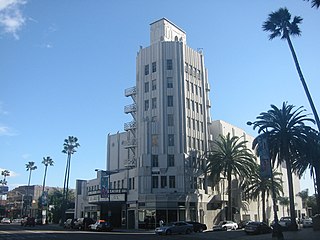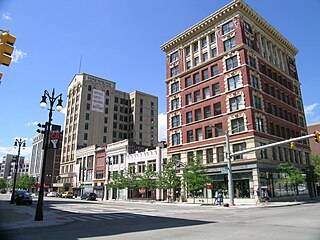
Cottonwood Falls is the largest city and county seat of Chase County, Kansas, United States. As of the 2020 census, the population of the city was 851. It is located south of Strong City along the south side of the Cottonwood River.

Sterling is a city in Rice County, Kansas, United States. As of the 2020 census, the population of the city was 2,248. Sterling is home to Sterling College.

The Saban Theatre is a historic theatre in Beverly Hills, California, formerly known as the Fox Wilshire Theater. It is an Art Deco structure at the southeast corner of Wilshire Boulevard and Hamilton Drive designed by architect S. Charles Lee and is considered a classic Los Angeles landmark. The building was listed on the National Register of Historic Places on April 3, 2012.

There are over 1,400 buildings, sites, districts, and objects in Kansas listed on the National Register of Historic Places in Kansas. NRHP listings appear in 101 of the state's 105 counties.

280 Broadway – also known as the A.T. Stewart Dry Goods Store, the Marble Palace, and the Sun Building – is a historic building located between Chambers and Reade Streets in the Civic Center district of Manhattan, New York City. Built in 1845-1846, it was the first commercial building in the Italianate style in New York City, and is considered the site of one of the nation's first department stores. 280 Broadway was designed by John B. Snook of Joseph Trench & Company, with later additions by other architects. It was built for the A. T. Stewart Company, which opened New York's first department store in it. It later housed the original New York Sun newspaper (1833–1950) and is now the central offices for the New York City Department of Buildings.
Union Pacific Railroad Depot, or similar, may refer to:

The Uptown Theater is a historic theater located in Kansas City, Missouri. The building was listed on the National Register of Historic Places in 1979 as the Uptown Building and Theatre.

The Broadway Avenue Historic District is a historic district located on a single city block along Broadway Avenue between Gratiot and East Grand River in downtown Detroit, Michigan. It was listed on the National Register of Historic Places in 2004. The Broadway Avenue Historic District joins the Randolph Street Commercial Buildings Historic District, a rare surviving commercial area which dates from the 1840s.

There are 73 properties listed on the National Register of Historic Places in Albany, New York, United States. Six are additionally designated as National Historic Landmarks (NHLs), the most of any city in the state after New York City. Another 14 are historic districts, for which 20 of the listings are also contributing properties. Two properties, both buildings, that had been listed in the past but have since been demolished have been delisted; one building that is also no longer extant remains listed.

18th and Vine is a neighborhood of Kansas City, Missouri. It is internationally recognized as a historical point of origin of jazz music and a historic hub of African-American businesses. Along with Basin Street in New Orleans, Beale Street in Memphis, 52nd Street in New York City, and Central Avenue in Los Angeles, the 18th and Vine area fostered a new style of jazz. Kansas City jazz is a riff-based and blues-influenced sound developed in jam sessions in the district's crowded clubs. Many notable jazz musicians of the 1930s and 1940s lived or got started here, including Charlie Parker. Due to this legacy, U.S. Representative Emanuel Cleaver said 18th and Vine is America's third most recognized street after Broadway and Hollywood Boulevard.

There are eight properties listed on the National Register of Historic Places (NRHP) in Linn County, Kansas. Two of the sites are the location of historic events. The Marais des Cygnes Massacre Site is the location of the Marais des Cygnes massacre, an 1858 event during Bleeding Kansas in which pro-slavery advocates kidnapped 11 anti-slavery settlers, killing five of them. John Brown temporarily used the site as a fort, and the property was listed on the NRHP in 1971. The Battle of Mine Creek Site preserves the location of the Battle of Mine Creek, which was fought in 1864 as part of Price's Raid during the American Civil War. Confederate general Sterling Price's army was retreating after being defeated at the Battle of Westport and was attacked by pursuing Union troops. Price's Confederate lost heavily in men and supplies. The site was added to the NRHP in 1973.

Louis Singleton Curtiss was a Canadian-born American architect. Notable as a pioneer of the curtain wall design, he was once described as "the Frank Lloyd Wright of Kansas City". In his career, he designed more than 200 buildings, though not all were realized. There are approximately 30 examples of his work still extant in Kansas City, Missouri where Curtiss spent his career, including his best known design, the Boley Clothing Company Building. Other notable works can be found throughout the American midwest.
George Putnam Washburn was a prominent architect practicing in Kansas. Washburn came to Kansas in 1870, worked as a carpenter and architect, and in 1882 opened an architecture practice in Ottawa, Kansas. His son joined his firm which became George P. Washburn & Son. In 1910 George P.'s son-in-law, Roy Stookey, joined the firm, and George P. retired. After George P. died in 1922 the firm became Washburn & Stookey.
Keene & Simpson was an American architectural firm of partners Arthur Samuel Keene (1875–1966) and Leslie B. Simpson from 1909 to 1955, after which it became Keene and Simpson and Murphy.

William Pratt Feth (1866–1959) and Myron K. Feth were architects in Kansas. A number of their works are listed on the U.S. National Register of Historic Places.

This is a list of the National Register of Historic Places listings in downtown Kansas City, Missouri.
Aaron T. Simmons, most commonly known as A.T. Simmons, was an American architect. He designed 71 Carnegie libraries, numerous courthouses, schools, churches and other public buildings, and most of the houses in Cedar Crest area of Normal, Illinois.
Overend & Boucher was an American architectural firm; Schmidt, Boucher & Overend was a related firm.
The Sterling Free Public Carnegie Library is a Carnegie library located at 132 N. Broadway in Sterling, Kansas. The library was built in 1916 through a $10,000 grant from the Carnegie Foundation and housed Sterling's library association, which formed in 1902. Architect R. W. Stookey of George P. Washburn & Co. designed the library in the Jacobethan style. The one-story red brick building features a cross gable roof. The main entrance is in a projecting gabled pavilion; its doorway has a quoined limestone surround. The frieze over the doorway and a date tablet in the entrance's gable are also made of limestone.
Cooper Hall, known also as Cooper Memorial College Building, located on N. Broadway Ave. in Sterling, Kansas, was built in 1887. It was listed on the National Register of Historic Places in 1974.














